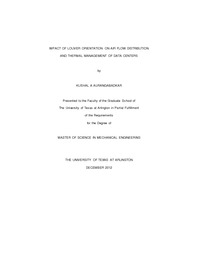
ATTENTION: The works hosted here are being migrated to a new repository that will consolidate resources, improve discoverability, and better show UTA's research impact on the global community. We will update authors as the migration progresses. Please see MavMatrix for more information.
Show simple item record
| dc.contributor.author | Aurangabadkar, Kushal A. | en_US |
| dc.date.accessioned | 2013-03-20T19:11:25Z | |
| dc.date.available | 2013-03-20T19:11:25Z | |
| dc.date.issued | 2013-03-20 | |
| dc.date.submitted | January 2012 | en_US |
| dc.identifier.other | DISS-12016 | en_US |
| dc.identifier.uri | http://hdl.handle.net/10106/11537 | |
| dc.description.abstract | Nowadays with the increasing use of technology, Traditional data centers are being replaced by the highly efficient Containerized or Modular Data centers. The cooling systems and constructional cost employed for Traditional Data centers is more and inefficient. The research intricate, about 23% of the power is consumed by HVAC cooling units and which in turn leads to increase in operational costs. Hence in order to reduce the operational costs, free cooling with Air side economizer is incorporated, compared to other cooling systems. Airflow Distribution plays an important role in the Thermal management, if the airflow is less in quantity it may lead to unpredictable thermal performance, while too much airflow may cause the server fans to blow-off or damage to the servers. Numerous research and study has been done on the use of louvers as shading devices for residential purposes but the study on Impact of the louver orientation on Air Flow Distribution and Thermal Management is limited. The amount of airflow allowed to pass through louvered window is function of its face velocity. The Air-Flow pattern through the louvered window is determined by the louver orientation. These two factors directed us to do a study on the Impact of the Louvers orientation on the Air Flow Distribution and Thermal Management of Data center. The first half of the thesis will discuss design and modeling of IT equipment's including Power cooling module, Air Plenum, Data centers using commercially available CFD software. It would also segregate there Heat load specifications along with a brief overview of Free Cooling and importance of louvers. The CFD modeling and analysis will include the advantages of using a compact model instead of the detailed model. The second part will discuss effects on the thermal performance and Air Flow Distribution for 0, 15,25,35,45 Degree Louver angle cases. However on comparing the simulation results for different angle cases, we find with the increase in the Louver angle, re-circulations are incurred which in turn affects the Thermal management inside the IT equipment's. The system is optimized comparing different louver angles. The study was done in collaboration with an industrial partner and such of the results have been adopted in various cooling systems. | en_US |
| dc.description.sponsorship | Agonafer, Dereje | en_US |
| dc.language.iso | en | en_US |
| dc.publisher | Mechanical Engineering | en_US |
| dc.title | Impact Of Louver Orientation On Air Flow Distribution And Thermal Management Of Data Centers | en_US |
| dc.type | M.S. | en_US |
| dc.contributor.committeeChair | Agonafer, Dereje | en_US |
| dc.degree.department | Mechanical Engineering | en_US |
| dc.degree.discipline | Mechanical Engineering | en_US |
| dc.degree.grantor | University of Texas at Arlington | en_US |
| dc.degree.level | masters | en_US |
| dc.degree.name | M.S. | en_US |
Files in this item
- Name:
- Aurangabadkar_uta_2502M_12016.pdf
- Size:
- 4.225Mb
- Format:
- PDF
This item appears in the following Collection(s)
Show simple item record


